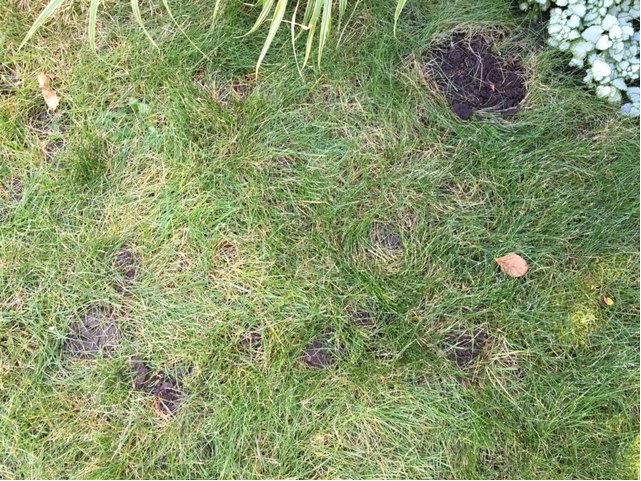Ask an Expert: What Is Digging up My Yard? The Nose Knows!
 In recent weeks, there have been a flood of calls and emails about mysterious divots and diggings in flower beds and lawns. Most look like a small hole or divot caused by an errant golfer.
In recent weeks, there have been a flood of calls and emails about mysterious divots and diggings in flower beds and lawns. Most look like a small hole or divot caused by an errant golfer.
In reality, the culprit may be none other than the striped skunk (Mephitis mephitis),
the largest and most common skunk in Utah. It is about the size of a large house cat and weighs 4 to 5 pounds. Striped skunks are black with two broad, white stripes running from the back of the head to the tip of the large, bushy tail.
The scent of a skunk can send a quick wave of panic through anyone. It is this lingering scent that provides the first clues as to what happened. In addition to being infamous for spraying when threatened, this nocturnal mammal can cause a host of other problems. Consider this information.
* Skunks will dig up lawns, golf courses and other sodded areas in search of white grubs and earthworms. They are also predators of waterfowl and game bird nests and can be found raiding backyard poultry houses and stealing eggs.
* Skunks are of public health concern because they are the major wildlife carrier of rabies. This disease is widespread in the skunk population throughout Utah. The incubation period — the period of time between exposure to a disease and the onset of clinical signs — for rabies can vary greatly. The typical incubation period is 3 to 8 weeks, but it can be as little as 9 days or as long as several years in some rare cases. The length an infected animal is actually transmissible also varies, ranging from 3 days to 2 weeks before the onset of symptoms. Once symptoms appear, the disease will normally kill the infected animal within a few days.
* Diseased animals may display abnormal behavior such as a staggering, blundering walk, aggression toward people or animals or daylight activity. Skunks displaying such abnormal behavior may be rabid and should be avoided or destroyed.
* Spotted skunks are protected and classed as furbearers and are managed by the Utah Division of Wildlife Resources by regulated trapping seasons. Striped skunks can be taken year-round without a license. However, they may be taken at any time without a hunting or furbearer license and by any method, provided local laws and ordinance s are not violated, such as discharging firearms within city limits.
s are not violated, such as discharging firearms within city limits.
* The best control for skunks around buildings is prevention. Do not allow them to become established in or under buildings. All holes in foundations or other points of possible entry should be sealed using sheet metal, cement, hardware cloth or bricks.
* If a skunk is already established under a building, seal all openings but one. Sprinkle a 2-foot square patch of flour in front of the opening. Check the flour patch 2 to 3 hours after dark for tracks. If the tracks show that the skunk has left, immediately seal the opening. When the skunk returns and cannot get back in, it will leave the area. This method should not be used in April, May or June since young skunks may be present and could be sealed in.
* To discourage a wandering skunk from digging up your lawn in its search for grubs, use carbaryl or trichlorfon. Always wear rubber gloves and rubber boots when applying insecticides to turfgrass. Make sure to irrigate the lawn with at least a half-inch of water, and allow the grass to dry before allowing people or pets onto the treated area.
* A skunk’s odor is its best line of defense and is one of the most persistent and offensive odors in nature. A diluted solution of vinegar or tomato juice can be used to remove most of the odor from pets, people and clothing. Clothing can also be soaked in weak solutions of ammonia. If the mishap occurs while camping, clothing can be smoked over a juniper fire.
* Walls, rooms or other areas that have been sprayed by a skunk can be treated with nuetroleum alpa. If the chemical is not available through local cleaning supply stores, check on-line. Also, many cleaning stores now have specific products to remove the odor.
* If you happen to get sprayed in the eyes, you will most likely experience a burning sensation and temporary blindness. Rinse your eyes with cold water to hasten your recovery.
* In spite of the problems they can cause, skunks are large consumers of harmful pests such as cutworms, armyworms, grasshoppers, white grubs and field mice.
* For more information on how to cope with skunks in your area, contact your local county Extension agent for a copy of the Extension bulletin, “Skunks,” or visit the Extension website at extension.usu.edu.
By: Terry Messmer, Utah State University Extension wildlife specialist, terry.messmer@usu.edu


 Utah 4-H & Youth
Utah 4-H & Youth